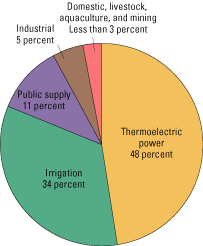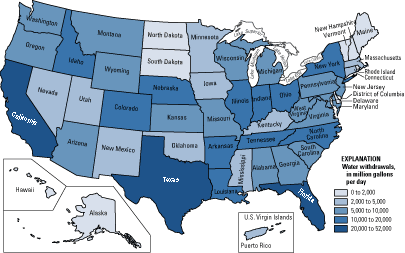 |
|
|
||||
| U.S. Geological Survey Fact Sheet 2005-3051 |
U.S. Geological Survey
By Deborah S. Lumia, Kristin S. Linsey, and Nancy L. Barber
This fact sheet is also available as a pdf.
|
 |
A report by the U. S. Geological Survey (USGS), “Estimated use of water in the United States in 2000” (USGS Circular 1268), shows that about 408 billion gallons of water per day were withdrawn for use in the United States during 2000. Withdrawals in 1990 averaged nearly 1,620 gallons per day per person; in 2000, the per capita average had declined to about 1,430 gallons per day. During the same decade, the United States experienced a population increase of about 33 million. Total withdrawals increased steadily from 1950 to 1980 but have varied less than 3 percent since 1985.
Seventy-nine percent of the 2000 withdrawals were from surface water, and the remainder was from ground water. About 85 percent of total withdrawals were freshwater because it is required for many uses. The saline withdrawals were nearly all from surface water. California, Texas, and Florida withdrew the most water; together they accounted for one-fourth of all water withdrawals in 2000.

Thermoelectric-power plants accounted for 48 percent of total withdrawals (195,000 million gallons per day [Mgal/d]) in 2000. Surface water was the source for more than 99 percent of total thermoelectric-power withdrawals, one third of which were saline. Historically, large supplies of water, mainly for cooling, had to be available to operate thermoelectric-power plants. For this reason, large power plants have been sited near the oceans, the Great Lakes, the Gulf of Mexico, and large rivers.
Withdrawals for irrigation were about 137,000 Mgal/d, second only to thermoelectric power nationwide. Irrigation represented 34 percent of total withdrawals and 40 percent of total freshwater withdrawals. Eighty-six percent of irrigation withdrawals, and 75 percent of the total land irrigated in 2000 were in the 17 conterminous Western States. Withdrawals for irrigation have remained nearly stable since 1985 despite an 8-percent increase in total acres irrigated.
During 2000, public suppliers withdrew about 43,300 Mgal/d of freshwater. Public-supply withdrawals constituted about 11 percent of total water withdrawals and about 13 percent of total freshwater withdrawals. About 63 percent of these withdrawals was from surface-water sources.
 Public-water
suppliers deliver water to users for household (domestic), industrial,
commercial, and other purposes.
If a home is not connected to a public-supply
system, the household needs its own water supply. Typically homes in urban settings are served by public-supply
systems, rural homes have their own wells, and suburban homes may have either source of water. During 2000, about 43.5 million people had their own water supply, using about 3,590 Mgal/d, most of which was ground water. During 1950, 62 percent of the population
was served by public supplies; by 2000 this had risen to 85 percent.
Public-water
suppliers deliver water to users for household (domestic), industrial,
commercial, and other purposes.
If a home is not connected to a public-supply
system, the household needs its own water supply. Typically homes in urban settings are served by public-supply
systems, rural homes have their own wells, and suburban homes may have either source of water. During 2000, about 43.5 million people had their own water supply, using about 3,590 Mgal/d, most of which was ground water. During 1950, 62 percent of the population
was served by public supplies; by 2000 this had risen to 85 percent.
Dependence on public supplies during 2000 varied from 49 percent in the U.S. Virgin Islands to 100 percent in the District of Columbia and Puerto Rico. (The District of Columbia, Puerto Rico, and the U.S. Virgin Islands are referred to here as States for brevity.)
For 2000, self-supplied industrial withdrawals were an estimated 19,700 Mgal/d or about 5 percent of total withdrawals. Industrial water use includes water used for the manufacture and production of commodities such as food, paper, chemicals, refined petroleum, and refined metals. Water for industrial uses may be delivered from a public supplier or be self-supplied. Surface water was the source for 82 percent of total industrial withdrawals. Less than 7 percent of total industrial withdrawals were from saline water.
Since 1985, withdrawals for industrial uses have declined steadily from about 25,800 Mgal/d to 19,700 Mgal/d in 2000. This decline may be due to a combination of factors. The number of production workers in manufacturing establishments has dropped about 5 percent since 1989; some intensive water-using industries, such as petroleum and coal products, have undergone large reductions1. Environmental laws and regulations also have encouraged more efficient use of water by industrial facilities.

Side-wheel sprinkler systems irrigate alfalfa in Utah. (Photo courtesy of Ron Nichols, USDA Natural Resources Conservation Service.)
Combined withdrawals for livestock, aquaculture, and mining were less than 3 percent of total withdrawals in 2000. Aquaculture includes fish farms and fish hatcheries. Only freshwater was considered for the livestock and aquaculture categories. During 2000, ground water accounted for 29 percent of the withdrawals for aquaculture. Livestock withdrawals were an estimated 1,760 Mgal/d, 58 percent from ground water. Mining water use is the use of water for extracting solid minerals (such as copper), liquids (such as petroleum), and gas (such as natural gas). Mining water use in 2000 was 58 percent ground water and 58 percent freshwater.

Total water withdrawals, 2000.
Based on the trend of water withdrawals as estimated by the USGS in 5-year intervals since 1950, total withdrawals, thermoelectric-power withdrawals, and irrigation withdrawals peaked about 1980. Public-water supply withdrawals have increased steadily since 1950, and domestic withdrawals also have generally increased since 1950. Self-supplied industrial is the only category to decline consistently during the past two decades. Although population increased almost 90 percent from 1950 to 2000, total withdrawals increased 127 percent during the same period.
Water-use estimates are published in USGS Circular 1268, “Estimated use of water in the United States in 2000.” Every 5 years, the USGS compiles water-use information in cooperation with State, Federal, and local agencies to document how the Nation’s water resources are used. Circular 1268 is the most recent publication in a series that presents 50 years of water-use data in the United States.
Federal, State, and local agencies play a key role in the collection and dissemination of water-use data. The USGS, by compiling and publishing water-use estimates for the Nation, provides water-resource planners with the information needed to address problems involving water-resource allocation and environmental impact. Having access to these data allows engineers, scientists, and policy makers to assess current and future water-use needs.
1U.S. Department of Commerce, Bureau of Economic Analysis, 2003, report SA25,
Income and employment tables by SIC industry, 1969 –2001, accessed July 11, 2003 at http://www.bea.gov/bea/regional
USGS Circular 1268 Estimated use of water in the United States in 2000 and USGS water-use contacts by State are available at http://water.usgs.gov/watuse .
Copies of this publication may be obtained from:
U.S. Geological Survey
Information Services
Box 25286
Denver Federal Center
Denver, CO 80225
This document is available in Portable Document Format (PDF): Fact Sheet 2005-3051 (1.3 MB)
To view this document, you need the Adobe Acrobat® Reader installed on your computer.
(A free copy of the Acrobat® Reader may be downloaded from Adobe Systems Incorporated.)